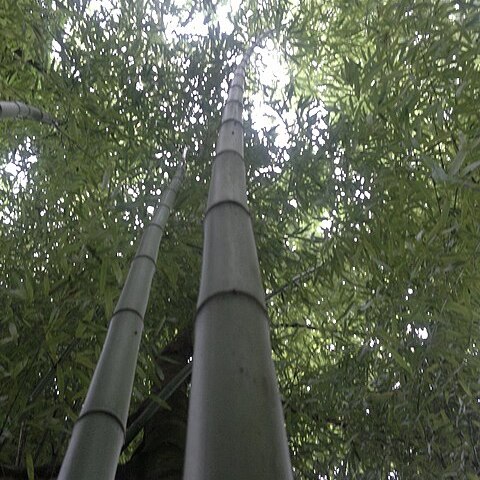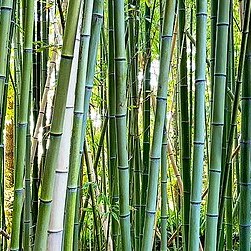Culms ca. 8 m, 4–5 cm in diam.; internodes 21–25 cm, initially white powdery; wall 4.5–7 mm thick; nodes initially purple; nodes with ridge slightly more prominent than sheath scar. Culm sheaths pale purple-brown, sometimes tinged with yellow-green, speckled brown, strigose, apex usually asymmetrical; auricles purple-brown to pale green, narrowly falcate; oral setae to 2 cm; ligule tall but narrow, ± asymmetrical with one side more decurrent than other, apex strongly convex, margin ciliate; blade reflexed, yellow-green with orange margins, linear, distally crinkled. Leaves 1–3 per ultimate branch; auricles inconspicuous; oral setae deciduous; ligule strongly exserted, margin laciniate; blade 9.5–13.5 × 1.2–1.8 cm. Flowering branchlets spicate, 2.5–8.5 cm, scaly bracts 3–5, gradually larger; spathes 4–7, pubescent; auricles small or absent; oral setae few or absent; blade orbicular-ovate to subulate. Pseudospikelets 1 or 2 per spathe, but absent in lower 3–5 spathes. Spikelets with 1 or 2 florets. Rachilla pubescent, with an awnlike extension. Glumes absent or 1; lemma ca. 2.5 cm, distally pubescent, apex acuminate, awnlike; palea slightly shorter than lemma, distally pubescent; lodicules narrowly elliptical, ca. 4 mm, margins ciliate. Anthers ca. 1.2 cm. Stigmas 3. New shoots late Apr, fl. May. 2n = 48*.
More
A bamboo. It grows 4-8 m tall. It forms clumps. The culms are 4-5 cm across. The canes are grooved on alternate sides between the nodes. The canes are green. The internodes are 21-25 cm long. There are 1-3 leaves on the last branch. The leaf blades are 10-14 cm long by 1-2 cm wide.
It is a temperate plant. It needs fertile, moist, humus rich, well-drained soil. It suits hardiness 7-10.
More
Woodland on mountains and plains.


